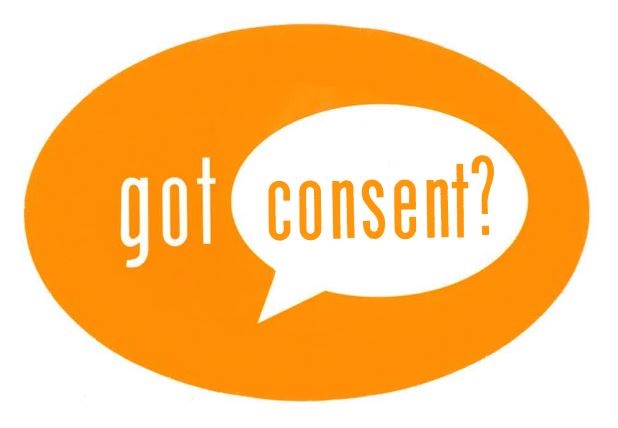Consent 101
Content Warning
This resource includes information about sexual consent and non-consent, and uses descriptions and example of both. Everyone has a different relationship to this content and a different level of comfort with it. If you are feeling triggered, you can call Tufts Counseling and Mental Health Services at 617-627-3030 and ask to speak with the Counselor-on-Call.

What is Consent?
Consent does not have to be confusing. It’s important to be clear about what it is, and what it isn’t. At Tufts and in the Sexual Misconduct Policy, we use the term “affirmative consent”. Affirmative consent is defined as an informed, deliberate and voluntary decision to engage in mutually desired sexual activity.
The Four Main Components of Consent

Consent is active, not passive.
That means you keep checking in - ideally verbally - with your partner.
Consent is mutual and ongoing.
This means it’s important to keep the lines of communication open. What may be OK with you or your partner(s) right now may not be OK later. This is true whether it’s your first hook up or if you’ve been with someone for months.

Consent is enthusiastic!
You want the other person to be as excited about sex with you as you are about sex with them. If they’re not, it’s time to stop and check in.

Consent is specific.
Saying yes to one thing (like going to the bed to make out) doesn’t mean you’ve said yes to other things (like having sex).
If you have all 4 of these components, then you’ve “got consent”.
What is NOT Consent?
At Tufts, we also believe it’s important to define what consent is NOT - or the absence of consent.

Silence does not equal consent.
Partners who do not physically oppose sex or don’t say anything at all are not necessarily giving you their consent. They may be experiencing fear, or be having a frozen trauma reaction, or not know how to tell you to stop.

The absence of a negative response ALSO does not equal consent. Just because someone doesn’t say “No” or “Stop” does not mean you have consent.

If your partner gives an unenthusiastic response like “I don’t know”, “uhm” or “Maybe”, this is also not consent. Remember, you want an enthusiastic YES and consent that is clearly and verbally articulated.
Consent: It's Simple as Tea
You may have seen this video before. Here at the OEO, we think its message about consent is SO good that it’s worth repeating!
The Bottom Line
Affirmative consent is active, mutual, enthusiastic and specific, It’s a clear ‘YES”, not a “maybe”. If you are ever unsure if you are getting a yes or a no, please STOP and talk about it.
What is Incapacity?

Incapacity happens when someone moves from being simply “drunk” or under the influence of other substances to being physically and/or mentally compromised. When someone is incapacitated, they are not aware or oriented enough to give consent - or even know they are giving it. That’s why it’s so important to be extremely careful if you are hooking up with people when you or they have been drinking or using drugs.
Signs of Incapacity
It can sometimes be difficult to tell when someone has moved from being intoxicated to being incapacitated. Different people display different symptoms or signs when they are incapacitated, and people can move from intoxication to incapacity quickly. That’s why it’s important to know some signs of incapacity. Keep in mind that not everyone displays the same signs. When in doubt, ask!
Some signs are:
- Slurring words or difficulty communicating or expressing yourself
- Limp body
- Throwing up
- Difficulty walking/driving/walking up or down stairs/riding a bike
- Falling asleep or nodding off
- Unconscious
If someone is displaying any of these symptoms, they have probably moved from being intoxicated or “drunk” to being incapacitated. That means they lack the full ability to understand what is happening to them and are NOT able to give consent.
What is Force?
![]() Many people think that force only refers to physical threats or violence. But there are actually four different types of force, and if any one of them is present, you did not receive authentic consent.
Many people think that force only refers to physical threats or violence. But there are actually four different types of force, and if any one of them is present, you did not receive authentic consent.
Force can be:
- Coercion or duress
- Intimidation or an abuse of power or authority
- Threats, including the presence of a weapon
- Physical violence
Coercion is defined as continual pressure or bullying used to compel someone to engage in sexual activity.

Intimidation is the use of real or perceived authority to influence another person with less authority and force them to submit to sexual activity through real or perceived intimidation or abuse of power. This is manipulative.
Threats are used to imply that there will be negative consequences to a person for failing to agree to sexual activity.
Physical violence is when a person uses power, violence or strength upon another person to physically force them to engage in sexual activity.
Autocorrect (It's On Us)
This video shows that there is no consent when incapacity and/or force is involved. Because of this, it may be triggering for some viewers. Note: while the video is heteronormative it depicts a situation which can happen with any gender combination or sexual orientation.
Need Help Now?
If you are feeling triggered, you can call Tufts Counseling and Mental Health Services at 617-627-3030 and ask to speak with the Counselor-on-Call.